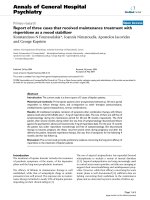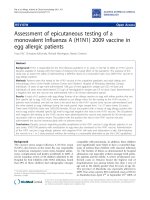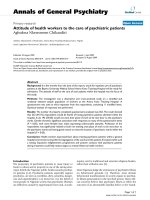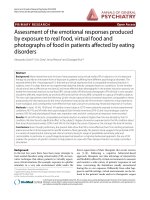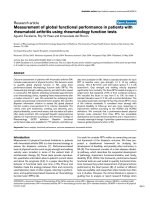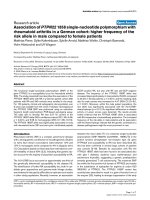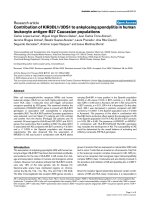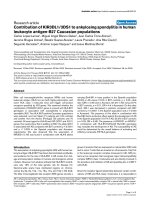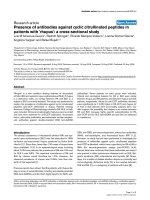Báo cáo y học: "Assessment of the effects and limitations of the 1998 to 2008 Abbreviated Injury Scale map using a large " pot
Bạn đang xem bản rút gọn của tài liệu. Xem và tải ngay bản đầy đủ của tài liệu tại đây (257.48 KB, 10 trang )
ORIGINAL RESEARCH Open Access
Assessment of the effects and limitations of the
1998 to 2008 Abbreviated Injury Scale map using
a large population-based dataset
Cameron S Palmer
1*
, Melanie Franklyn
2
Abstract
Background: Trauma systems should consistently monitor a given trauma population over a period of time. The
Abbreviated Injury Scale (AIS) and derived scores such as the Injury Severity Score (ISS) are commonly used to
quantify injury severities in trauma registries. To reflect contemporary trauma management and treatment, the
most recent version of the AIS (AIS08) contains many codes which differ in severity from their equivalents in the
earlier 1998 version (AIS98). Consequently, the adoption of AIS08 may impede comparisons between data coded
using different AIS versions. It may also affect the number of patients classified as major trauma.
Methods: The entire AIS98-coded injury dataset of a large population based trauma registry was retrieved and
mapped to AIS08 using the currently available AIS98-AIS08 dictionary map. The percentage of codes which had
increased or decreased in severity, or could not be mapped, was examined in conjunction with the effect of these
changes to the calculated ISS. The potential for free text information accompanying AIS coding to improve the
quality of AIS mapping was explored.
Results: A total of 128280 AIS98-coded injuries were evaluated in 32134 patients, 15471 patients of whom were
classified as major trauma. Although only 4.5% of dictionary codes decreased in severity from AIS98 to AIS08, this
represented almost 13% of injuries in the registry. In 4.9% of patients, no injuries could be mapped. ISS was
potentially unreliable in one-third of patients, as they had at least one AIS98 code which could not be mapped.
Using AIS08, the number of patients classified as major trauma decreased by between 17.3% and 30.3%. Evaluation
of free text descriptions for some injuries demonstrated the potential to improve mapping between AIS versions.
Conclusions: Converting AIS98-coded data to AIS08 results in a significant decrease in the number of patients
classified as major trauma. Many AIS98 codes are missing from the existing AIS map, and across a trauma
population the AIS08 dataset estimates which it produces are of insufficient quality to be used in practice.
However, it may be possible to improve AIS98 to AIS08 mapping to the point where it is useful to established
registries.
Background
Accurately determining the burden of significant injury
within a given population is an essential role of a
trauma syst em. Trauma data can be used for a range of
appli cations including monitoring changes in injury epi-
demiology, trauma management and outcome over time,
appropriate direction of funding, and population or out-
come comparisons between institutions or regions. In
order to monitor trauma systems most effectively,
trauma registries should use contemporary terminology
and tools; ideally, data collected using these tools should
also be readily comparable.
The Abbreviated Injury Scale (AIS) [1] is widely used
to monitor and evaluate anatomic injuries within trauma
populations. Its utility has increased with the develop-
ment of AIS-derived scores such as the Injury Severity
Score(ISS)[2]andtheNewInjurySeverityScore
(NISS) [3]. The 1990 AIS version and its 1998 update
(AIS98) [4] were extensively adopted [5,6] and large
registries based on these coding systems exist. However,
* Correspondence:
1
Trauma Service, The Royal Children’s Hospital Melbourne, Flemington Rd,
Parkville 3052, Australia
Full list of author information is available at the end of the article
Palmer and Franklyn Scandinavian Journal of Trauma, Resuscitation and Emergency Medicine 2011, 19:1
/>© 2011 Palmer and Franklyn; licensee BioMed Central Ltd. This is an Open Access article distributed under the terms of the Creative
Commons Attribution License ( nses/by/2.0), which perm its unrestricted use, distribution, and
reproduction in any medium, provided the original wor k is properly cited.
the epidemiological, diagnostic, management and
outcome expectations inherent in these AIS versions
(both in the available codes and in the severities
assigned to each code) have been superseded by the
2005 AIS version (AIS05) [7] and its su bsequent 2008
minor update (Abbreviated Injury Scale 2005 Update
2008 - AIS08) [8].
In order for trauma registries to reflect current man-
agement and treatment, t he more contemporary AIS08
should be adopted. However, for established registries,
there are significant limitations regarding the compari-
son of existing (AIS98) data to datasets compiled using
AIS05 or A IS08 due to the magnitude of the changes
made between the versions. The AIS codeset has
expanded in size from 1341 codes in AIS98 to 1983
codes in AIS05, and then 1999 codes in AIS08. New
sections allowing coding of drowning, asphyxia, and
caustic corrosion injuries have also been included. Addi-
tionally, the consensus-derived sever ities of hundreds of
codes have changed to reflect current clinical relevance
in injury diagnosis, management and outcome [5]. For
example, due to better treatment and management,
many injuries will be assigned an AIS08 code which is
lower in severity than its AIS98 equivalent.
Due to the differences between AIS versions, the crea-
tors of AIS developed a mapping system to convert data
from AIS98 to AIS05/08. Thi s mapping system (denoted
‘ dictionary map’ from this point on) consists of two
additional lists of AIS98 codes in the AIS05 and AIS08
dictionaries, which can be used to convert AIS98 data
to AIS05/08 or vice versa. In theory, the dictionary map
can be used to generate estimates of the data (for indivi-
dual injuries, patients or an entire po pulation) which
would have been produced had the data been directly
coded using the other version. For example, applying
the dictionary map to AIS98-coded registry data should
provide an AIS08-based injury dataset comparable to
the dataset produced from directly coded AIS08 data. It
has been asserted that by using the dictionary map,
“conversions to and from AIS 98 should be relatively
easy” [5].
A recent study conducted within the Victorian State
Trauma System (VSTS) [9] d emonstrated that the
AIS05 dictionary map provided AIS estimates which
gave a reasonable degree of comparability between
mapped and double-coded data. In this study, mapping
‘backwards’ ( i.e. from AIS05 to AIS98) gave slightly bet-
ter performance than mapping ‘ forwards’ (i.e. from
AIS98 to AIS05), a result which might be expected as
AIS05 contains considerably more codes and specificity
than AIS98. However, although this study concluded
that backwards mapping was preferable given the cur-
rently available mapping tools, there are significant
objections to using backwards mapping in practice.
Firstly, mapping AIS05/08 codes back to AIS98 will be
impractical when successive AIS versions are intro-
duced. Secondly, backwards mapping from the more
contemporary AIS05/08 to AIS98 will result in assess-
ments of patients’ injuries which are outdated. Finally, it
is simply illogical to adopt a contemporary and more
complicated AIS version, only to convert the resultant
data back to an outdated earlier version.
A number of recently published studies [9-12] identi-
fied differences between data coded using AIS98 and
data coded using AIS05/08 in terms of the number of
patients classified as ‘ major trauma’ - an important, if
often arbitrary discriminator between severely and less
severely injured patients. Using the common threshold
of an ISS >15 [13], t he number of patients classified as
major trauma has been estimated to decrease by
between 8% and 24% using AIS05/08 when compared
with AIS98. However, there are a number of potential
limitations with these estimates. The smallest of these
estimates was derived from a sample of patients with
maxillofacial injury [12]. It has been noted that severity
differences between AIS05/08 and earlier versions are
not as great for facial injuries [9,14]. The three remain-
ing studies were conducted in large (Le vel I) trauma
centres. It is likely that the injury profile of trauma
patients at these hospitals will differ from the in jury
profile of an entire trauma system. Finally, two of these
studies [9,10] included only major trauma patients. It is
possible that some less severely injured patients treated
at these institutions sustained injuries which increased
in severity using AIS05/08 (potentially increasing their
ISS from below to above 15 i n AIS05/0 8). Such patients
would offset the noted decrease in major trauma num-
bers. Salottol o et al [11], who evaluated both major and
non-major trauma patients, noted that approximately
1% of patients had an AIS05-based ISS which was in a
higher ISS bracket than their AIS98-based ISS.
Additional problems have arisen due to the increased
specificity in AIS05/08, where some injury types which
were represented by only one code in AIS98 now have
two or more corresponding codes in AIS08. A com-
monly occurring example would b e a small (less than 1
cm thick), unilateral cerebral subdural haematoma
(SDH). When directly coding this injury, it would be
assigned an AIS severity level of 4 (severe) in AIS98; in
AIS08, the injury can be assigned either level 3 (serious)
or level 4, depending on if the thickness of the haema-
toma (in this instance, more or less than 6 mm thick).
However,mappingoftheAIS98codetoAIS08would
allocate the le vel 4 AIS08 code for a ll instances. This
could potentially affect comparisons of, fo r example, ISS
or NISS between patients whose data had been mapped
from AIS98, and patients who were directly coded using
AIS08.
Palmer and Franklyn Scandinavian Journal of Trauma, Resuscitation and Emergency Medicine 2011, 19:1
/>Page 2 of 10
In addition to AIS codes, many trauma registries and
crash databases collect free text descriptions of each
injury, documented by the injury coder at the time the
AIS code is assigned and base d on available information
identified from the patient’s medical file. Alongside a
‘small cerebral SDH’ AIS98 code, for example, a descrip-
tion of “5 mm right parietal SDH” may be recorded.
Free text descriptions have been used in previous
trauma research; i n the landmark Major Trauma Out-
come Study, the study method required that such
descriptions were the sole source of information used to
assign both AIS codes (in two separate versions) and
International Statistical Classification of Disease (ICD)
codes [15]. Where available, it is possible that free text
information could be used to improve the accuracy of
AIS mapping without needing to re-code patients from
medical records. However, this concept has not pre-
viously been tested.
A final limitation of AIS mapping which has been
identified is the occurrence of codes which have not
been assigned equivalents in the dictionary map. In the
VSTS double-coding study [9], 11% of patients could
not have an ISS calculated from data which had been
mapped from AIS98 to AIS05. This issue is t herefore
potentially significant, but has not been sufficiently
explored. Examples from AIS98 are the codes for ‘closed
or undisplace d humerus fracture’, or the combined code
for ‘ fracture of 1 rib with haemo- or pneumothorax’.In
many instances , it is unlikely that this has occurred due
to an equivalent code not existing in AIS05/08, but
rather in order to keep the dictionary map simple to
read and use. In the first example, the AIS05/08 code
for (n on-open) humerus fracture (not further specified;
NFS) has already been assigned an equivalent AIS98
code when mapping from AIS98 (that for ‘humerus frac-
ture NFS’ ). Codes for single rib fractures, haemothorax
and pneumothorax also exist in AIS05/08, but a map
between these and the combined code in AIS98 (where
a patient has sustained two injuries) would be difficult
to represent. Such issues are beli eved to affect forwards
mapping from AIS98 more than b ackwards mapping
from AIS05/08.
Objectives
Theaimofthecurrentstudywastodeterminehow
changes in injury severity between the AIS98 and AIS08
dictionaries might affect a large, establish ed trauma reg-
istry when existing (AIS98-coded) data is mapped to
AIS08 using the available dictionary map. More specifi-
cally, the effect of AIS version change on major trauma
numbers will be ascertained by evaluating both major
and non-major trauma patients. Additionally, the quality
of data conversion from AIS98 to AIS08 will be assessed
by examining the effect of injuries which cannot
currently be mapped, or injuries which have more than
one a vailable mapping option. Finally, the potential for
free text injury descriptions to improve data conversion
from AIS98 to AIS08 will be examined by evaluating
cerebral SDH injuries.
Method
TheVictorianStateTraumaRegistry(VSTR),alarge,
well-established population-based registry, was queried
for the eight year period from 1st July 2001 to 30th
June 2009 in order to identify all injuries sustained by
patients meeting VSTR inclusion criteria. The VSTR
collects data on patients with acute-phase injury who
are t ransferred to or receivedfromaVSTShospital,or
who have a length of stay greater than 72 hours [16];
consequently, patient data was not limited t o major
trauma. In addition to an ISS >15, patients could be
defined as major trauma if they met any o f the ad di-
tional Victorian major trauma criteria - death due to
injury, injury requiring urgent surgery, or an ICU stay of
more than 24 hour s with mechanical ventilation [16].
The information obtained included the VSTR patient
number, the assigned AIS98 code (with corresponding
free text description as written by VSTS coders) and the
deter mined major trauma status (including which of the
Victorian criteria were met).
The AIS98 to AIS08 dictionary map i n the AIS08 dic-
tionary [8] was used to generate AIS08 estimates for all
AIS98 codes. Where particular AIS98 code s appeared in
the dictionary map on more than one occasion, the first
listedAIS08codewasused-generally,thiswasthe
default (’ NFS’ ) code. An exception was if the AIS08
mapping options differed in their severity levels; in such
instances the first listed AIS08 code with the lowest
available severity level was us ed in keeping with conser-
vative AIS coding rules [8]. Where no AIS08 equiv alent
was provided in the dictionary map, this was noted.
Once mapping had been completed, AIS08-based ISS
values were calculated from the mapped codes.
In order to examine the potential effect of mapping on
injury severities in more detail, AIS98 codes which had
been assigned most and least frequently in the VSTR
dataset were examined. Of the 1341 codes in the AIS98
dictionary, two subgroups were identified based on code
occurrence in the VSTR - codes which had been
assigned an av erage of 100 times per year or more were
deemed ‘frequently assigned’, and those which had been
assigned an average of once per year or less were
deemed ‘rarely assigned’.
Where cerebral SDH codes had been assigned in
AIS98, accompanying free text descriptions were
searched for text strings such as ‘tiny’, ‘thin’ and ‘small’
within the descriptions, as well as for measurements of
thickness and volume (for example, a SDH less than 6
Palmer and Franklyn Scandinavian Journal of Trauma, Resuscitation and Emergency Medicine 2011, 19:1
/>Page 3 of 10
mm thick) . Once these had been performed, applicable
descriptions were manually reviewed to assess whether
detected injury descriptions were relevant. Where the
free text description indicated that the most appropriate
AIS08 code differed from the A IS08 code in the diction-
ary map, this was noted.
A paired Wilcoxon signed-rank test was used to com-
pare calculated ISS across the whole population using
AIS98 and mapped AIS08 codes. Where categorical data
was evaluated, chi-square tests were performed where
possible, and standardised residuals were assessed in
order to ident ify specific differences between cells [17].
A p-value of 0.05 was taken as indicative of s tatistical
significance, and 95% confidence intervals were calcu-
lated using Wilson’s asymptotic calculation method [18]
where appropriate. To co mpensate for the number of
tests pe rform ed, however, a cons ervative p-value of 0.01
was used to indicate significance in statistical
comparisons.
Results
Over the eight year period evaluated, 32134 patients
with a total of 128280 coded injuries were in cluded in
the VSTR. Using the Victorian major trauma criteria,
15471 (48%) of the patients were classified as major
trauma with a total of 85180 coded injuries. Of these
patients, 12819 had an ISS >15 and they represented
83% of major trauma patients, or 40% of the total
patient group.
Table 1 shows the changes in AIS injur y severity (AIS
level) when all 1341 codes in the AIS 98 dictionary are
mapped forwards from AIS98 to AIS08. Within the dic-
tionary map, 4.5% of codes had decrease d in severity,
while 0.7% increased; just over 12% of codes either did
not currently have an AIS08 map, or had multiple possi-
ble AIS08 options of different severities when mapping
the AIS98 code. There were differences between these
proportions and the corresponding proportions of
VSTR-assigned AIS98 codes seen in the same table. In
practice, the majority of coded injuries (74.4%) did not
change in severity when mapped to AIS08. Only a
negligible proportion (0.1%) increased in severity, while
almost 13% of the injuries decreased in severity - in
other words, the number of injuries which decreased in
severity was more than 250 times greater than the num-
ber which increased in severity. In addition, 12.8% of
injuries either could not be mapped to AIS08 (10.5%),
or had some uncertainty as to the accuracy of the sever-
ity of the mapped codes (2.3%). These differences were
statistically significant (p < 0.001) - those AIS98 codes
which increased in severity occurred less frequently in
practice, while those which decreased in severity
occurred more frequently.
Differences between rarely and frequently
assigned AIS98 codes
Of the 1341 code s in th e AIS98 dictionary, only 1180
had been assigned at least once. The incidence of codes
assigned showed a highly skewed distribution. There
were 43 codes (liste d in Tabl e 2) w hich had been fre-
quently assigned; these represented only 3.2% of the
available codes in the AIS98 dictionary but accounted
for 44.0% of the injuries sustained. Conversely, more
than half of the codes in the AIS98 dictionary (679
codes, or 50.6% of avail able codes) were rarely assigned;
this included 161 codes whic h had not b een assigned at
all in the 8-year period (Table 3).
Table 4 demonstrates the changes in injury severity
when both rarely assigned and frequently assigned
VSTR dataset injuries are mapped from AIS98 to AIS08.
Six of t he nine codes which increased in severity when
mapped to AIS08 were rarely or never assigned, while
none of the frequently assigned codes increased in
severity. While AIS98 codes which decreased in severity
in AIS08 accounted for only 2.5% of rarely assigned
codes and 4.5% of the overall AIS98 codeset (Table 1),
they made up 16.3% of frequently assigned codes.
Effect of AIS98 codes missing from the dictionary map
Of the 128280 injuries, 1353 3 had been assigned an
AIS98 code which was not listed in the dictionary map
(shown earlier in Table 1). These injuries were spread
Table 1 AIS severity changes for AIS98 dictionary codes and VSTR dataset injuries when mapping to AIS08
AIS injury severity AIS98 dictionary
codes
VSTR dataset
injuries
Overall chi square
Codes Incidence Injuries Incidence
Same in AIS08 1109* 82.7% 95419 74.4% Χ
2
= 188.25; p < 0.001
Increases in AIS08 9* 0.7% 65 0.1%
Decreases in AIS08 61* 4.5% 16318 12.7%
Multiple mapping options in AIS08 (available options
have different severity levels)
9* 0.7% 2945 2.3%
No map currently available (no AIS08 map in dictionary map) 153 11.4% 13533 10.5%
Total 1341 100.0% 128280 100.0%
* = p < 0.01 on examination of standardised residuals for Χ
2
test (|z score| >2.58).
Palmer and Franklyn Scandinavian Journal of Trauma, Resuscitation and Emergency Medicine 2011, 19:1
/>Page 4 of 10
evenly across the VSTR population, so that 10597 of the
32134 patients in the VSTR (33.0%) had sustained at
least one injury which could not be mapped to AIS08.
The majority of these patients had sustained other inju-
ries which could be mapped, permitting calculation of at
least a partial ISS estimate. However, 1565 patients
(4.9% of all study patients) had been assigned AIS98
codes where none of these c odes could be mapped to
AIS08 and hence could not h ave any AIS08-based ISS
calculated.
Table 2 Frequently assigned AIS98 codes in VSTR, with dataset incidence and effect of mapping to AIS08
Incidence AIS98
code
Brief injury description AIS severity level if mapped to
AIS08
2774 140684.3 Cerebral subarachnoid haemorrhage Decreased
2477 210602.1 Minor(superficial) skin laceration to face Same
2152 650620.2 Lumbar spine fracture - transverse process Same
1993 210402.1 Skin contusion/haematoma to face Same
1974 140652.4 Small cerebral subdural haematoma Same
1973 150200.3 Base of skull fracture - NFS Same
1778 110402.1 Skin contusion/haematoma to scalp Same
1737 752200.2 Clavicle fracture Same
1606 851606.2 Fibula fracture - head/neck/shaft Same
1597 441406.3 Unilateral lung contusion Decreased
1586 110602.1 Minor(superficial) skin laceration to scalp Same
1435 442202.3 Thoracic cavity injury with haemo-/pneumothorax, NFS Multiple severities available
1344 752804.3 Radius fracture - open/displaced/comminuted Decreased
1318 810202.1 Skin abrasion to lower extremity Same
1295 650420.2 Thoracic spine fracture - transverse process Same
1291 250800.2 Maxilla fracture - NFS Same
1289 450220.2 Rib cage fracture - 2-3 rib fractures any location Same
1287 852600.2 Pelvic fracture - NFS Same
1277 650430.2 Thoracic spine fracture - vertebral body, NFS Same
1277 852602.2 Fractured pelvis - closed/undisplaced No map currently available
1215 710202.1 Skin abrasion to upper extremity Same
1194 852604.3 Pelvic fracture - open/displaced/comminuted Same
1186 450232.4 Rib cage fracture - >3 ribs on one side,≤3 on other side, with haemo-/pneumothorax No map currently available
1160 853422.3 Tibia fracture - shaft, open/displaced/comminuted Multiple severities available
1087 851814.3 Femur fracture - shaft Same
1085 450804.2 Sternum fracture Same
1070 753000.2 Scapula fracture Same
1049 160202.2 Concussive injury - unconsciousness < 1 hr Same
1028 710602.1 Minor(superficial) skin laceration to upper extremity Same
1026 650432.2
Thoracic spine fracture - vertebral body, minor compression (< = 20% loss of anterior
height)
Same
1022 910200.1 Skin
abrasion, multiple regions or NFS Same
984 441410.4 Bilateral lung contusion Decreased
964 810402.1 Skin contusion/haematoma to lower extremity Same
958 210202.1 Skin abrasion to face Same
948 752604.3 Humerus fracture - open/displaced/comminuted Decreased
929 251800.2 Zygoma fracture Decreased
917 510402.1 Skin contusion/haematoma to abdomen Same
886 810602.1 Minor(superficial) skin laceration to lower extremity Same
883 753204.3 Ulna fracture - open/displaced/comminuted Decreased
870 450222.3 Rib cage fracture - 2-3 rib fractures any location, with haemo-/pneumothorax No map currently available
849 650230.2 Cervical spine fracture - vertebral body, NFS Same
826 450212.1 Rib cage fracture - 1 rib Same
800 210600.1 Skin laceration to face, NFS Same
Palmer and Franklyn Scandinavian Journal of Trauma, Resuscitation and Emergency Medicine 2011, 19:1
/>Page 5 of 10
Table 5 summarises the injury types sustained by the
1565 patients for whom no codes could be mapped
from AIS98 to AIS08. Injuries to the pelvis and its asso-
ciated bony joints, which underwent extensive classifica-
tion revision in AIS08, were the most common type of
injury which could not be mapped. This was followed
by combined thoracic injury codes which had be en split
into two codes in AIS08. Although the majority of these
patients (1451, or 92.7%) only sustained one injury,
thereweresomepatientswithmultipleinjureswhere
none could be mapped.
Effect on ISS and major trauma classification
Out of 30569 patients with a calculable ISS using AIS08,
11960 (39.1%) had an ISS which differed from the ISS
calculated using AIS98 codes. More than 98% of
patients whose ISS changed using AIS08 had a decrease
in ISS; only 22 2 patients (0.7% of patients with a calcul-
able ISS) had a higher ISS using mapped AIS08. Overall,
the median ISS decreased between AIS98 (10; interquar-
tile range 8-20) and mapped AIS08 (9; interquartile
range 5-17). Paired Wilcoxon signed rank testing
demonstrated that overall ISS was significantly lower
using mapped AIS08 (p < 0.001).
Table 6 demonstrates the effect of mapping from
AIS98 to A IS08 on calculated ISS by grouping. When
codes from all 32134 patients were evaluated, the num-
ber of patients with a calculated ISS >15 decreased by
28.1% using mapped AIS08 data, compared with AIS98
data. For 3649 patients, the ISS dropped from above to
below ISS 15, while for 44 patients, the ISS increased
from less than to greater than 15. The decrease in ISS
>15 patients was also assessed for the subset of 21537
patients whose AIS98 codes could all be mapped to
AIS08. For this group, the decrease in the nu mber of
ISS >15 patients was smaller, with only an 18.2%
decrease in AIS08.
The type of Victorian major trauma criteria which was
met was assessed for all patients (Table 7). A total of
9267 patients met at least one of the major trauma cri-
teria other than ISS >15 (death after injury, ventilated
ICUstayorurgentsurgery).Useofthesecriteriales-
sened the decrease in the number o f patients classified
as major trauma when data was mapped to AIS08. If
ISS >15 had been the sole major trauma criterion, the
number of major trauma patients would have decreased
by up to 30.3%. However, using both ISS >15 and the
additional Victorian criteria, the decrease was only
17.3%.
Evaluation of free text descriptions for cerebral SDH
A total of 3541 cerebral SDH injuries were identified;
overall, 11.0% of patients in the VSTR had sustained a
cerebral SDH. The majority of these injuries (2580, or
Table 3 Occurrence of rarely assigned AIS98 codes in
VSTR
Occurrences
in
VSTR dataset
Number of AIS98
codes
with this incidence
% of available AIS98
codes (out of 1341
codes)
0 161 12.0%
1 130 9.7%
2 111 8.3%
3 67 5.0%
4 61 4.5%
5 40 3.0%
6 49 3.7%
7 34 2.5%
8 26 1.9%
Total 679 50.6%
Table 4 AIS severity changes in AIS08 for rarely assigned and frequently assigned AIS98 codes in VSTR
AIS injury severity All AIS98 codes Rarely assigned codes Frequently assigned codes
Codes % of code type Codes % of code type
Same in AIS08 1109 581 85.6% 31 72.1%
Increases in AIS08 9 6 0.9% 0 0.0%
Decreases in AIS08 61 17 2.5% 7 16.3%
Has multiple severity levels in AIS08 9 1 0.1% 2 4.7%
No map currently available 153 74 10.9% 3 7.0%
Total 1341 679 100.0% 43 100.0%
Table 5 Injury types sustained by 1565 patients for
whom no codes could be mapped to AIS08
Injury type Number of injuries Incidence
Concussive closed head injury 131 7.7%
Other injury to head or face 48 2.8%
Combined thoracic injury code 498 29.3%
Other injury to chest or abdomen 65 3.8%
Upper limb injury 142 8.4%
Pelvic or pelvic joint injury 507 29.8%
Lower limb injury 73 4.3%
Burn injury 235 13.8%
Total 1699 100.0%
Palmer and Franklyn Scandinavian Journal of Trauma, Resuscitation and Emergency Medicine 2011, 19:1
/>Page 6 of 10
72.9%) had an AIS98 code of level 4 severity assigned,
and the remaining 961 patients had a level 5 severity.
When using the dictionary map only, 329 of the AIS
level 5 injuries decreased to level 4, and all 606 NFS
codes decreased in severity from level 4 to level 3
(Table 8). When free text descriptions were evaluated,
the mapped AIS08 codes for 319 injuries (accounting
for 9.0% of cerebral SDH injuries) changed; these
changes affected 37 of the NFS codes, 251 of the small
(unilateral) codes and 31 of the (small) bilateral codes.
All but ten of these 319 changes involved a change in
theseverityoftheAIS08codefromwhathadoriginally
been mapped. A total of 251 SDH codes changed to a
lower severity than had originally been mapped in
AIS08 while 58 codes changed to a higher severity. This
included 31 bilateral SDH injuries which remained at
level 5 severity following mapping to AIS08 after the
thickness of the haematoma o n one side was noted to
be >10 mm. It was also noted that 37 (6.1%) of the NFS
codes contained infor mation in the free-text descriptors
which permitted mapping to a more specific SDH code -
so it could be a rgued that the NFS code should not have
been assigned in AIS98.
Discussion
This is the largest study evaluating t he effect of AIS
mapping performed to date. It confirmed that using the
dictionary map to convert a trauma dataset from AIS98
to AIS08 significantly decreases the overall injury sever-
ity of t he dataset. This has a substantial effect on the
number of patients classified as major trauma, although
in the VSTR, the decrease in major trauma numbers
was offset by the use of major trauma criteria other
than just an ISS >15. The inclusion of non-major
trauma patients did not result in a substantial number
of ‘new’ patients being classifie d as maj or trauma using
AIS08, as very few patients recorded an increase in ISS
in AIS08. This indicates that estimates from previous
studies which have only used major trauma patients in
evaluating changes in major trauma classification are
Table 6 Change in ISS level (ISS <15 or ISS >15) when using AIS dictionary map
All patients Only patients with all codes
mappable to AIS08
Patients Incidence Patients Incidence
ISS >15 using AIS98
ISS >15 using mapped AIS08 8894 27.7% 6125 28.4%
ISS <15 using mapped AIS08 3649 11.4% 1406 6.5%
No injuries in current AIS map 276 0.9%
ISS <15 using AIS98
ISS >15 using mapped AIS08 44 0.1% 37 0.2%
ISS <15 using mapped AIS08 17982 56.0% 13969 64.9%
No injuries in current AIS map 1289 4.0%
Total patients 32134 100.0% 21537 100.0%
Total ISS >15 patients
using AIS98
12819 7531
Projected decrease using
AIS08 (95% CI)
3605 28.1%
(27.4-28.9%)
1369 18.2%
(17.3-19.1%)
Table 7 Victorian major trauma criteria met using AIS98 and (mapped) AIS08
Criteria met using AIS98 (Projected) criteria met
using AIS08
Patients Incidence Patients Incidence
ISS >15 only 6204 40.1% 3528 27.5%
Both ISS >15 and other criteria 6615 42.8% 5410 42.3%
Non-ISS criteria only 2652 17.1% 3857 30.1%
Total major trauma patients 15471 100.0% 12795 100.0%
Projected decrease using
AIS08 (95% CI)
17.3% (16.7-17.9%)
Total ISS >15 patients 12819 82.3% 8938 69.9%
Projected decrease using
AIS08 (95% CI)
30.3% (29.5-31.1%)*
* = Estimate includes 276 patients for whom an ISS could not be calculated in AIS08.
Palmer and Franklyn Scandinavian Journal of Trauma, Resuscitation and Emergency Medicine 2011, 19:1
/>Page 7 of 10
likely to have b een reasonably accurate for the popula-
tions which were evaluated.
The current study also illustrated that calculating the
change in the number of classified major trauma
patients may depend on whether AIS-based criteria
(such as ISS >15) alone are used. The number of major
trauma patients decreased by 17.3% using Victorian
major trauma criteria, but decreased by 30.3% when
using an ISS >15 alone. These findings are comparable
with previous studies [9-11] which showed that between
14 and 2 4% of patients currently designated as major
trauma using an ISS >15 would be reclassified as non-
major in AIS05/08, although some variation in these
percentages is expected due to the different trauma
datasets or populations used.
Effect of AIS98 codes missing from the dictionary map
The absence of 153 AIS98 codes from the dictionary
map repre sents a second factor which has a substantial
impact on estimates of major trau ma classification using
AIS08. These codes disproportionately affect the patient
population, as one third of patients had at least one of
these codes (potentially affecting ISS), and a small but
not insignificant proportion (4.9%) of patients could not
have any ISS calculation performed. The injuries sus-
tained by these patients were heavily biased towards two
particular injury types (pelvic injuries and complex thor-
acic injuries). Conversely, it may be said that the set of
AIS98 codes which can be mapped to AIS08 is biased
away from these injury types.
The proportion of injury codes which experienced
mapping difficulties overall is also worth comment. A
total of 16383 injuries were identified as changing in
injury seve rity (increasing or decreasing) when mapped
to AIS08. However, there w ere 16478 injuries which
either could not be mapped to an AIS08 injury, or
mapped to a known severity level. In other words, the
estimateofthechangeinseverityofthestudypopula-
tion contains a margin of uncertainty which is greater
than the measurable change s from AIS98 to AIS08.
Consequently, the issue of missing codes carries major
implications for the conversion of existing AIS98-coded
trauma datasets to AIS08, as they introduce an unaccep-
tably large degree of uncertainty into the resultant
(mapped) codeset. This forms a considerable barrier to
the ideal aim of accurate and complete mapping of
existing data to AIS08, which is necessary t o perform
meaningful, unbiased comparisons within a population
over time, or between trauma systems using different
AIS versions.
Use of free text descriptions in AIS mapping
Evaluation of free text descriptions for cerebral SDH
data showed that this information improved the accu-
racy of mapping t o AIS08. Compared with the codes
automatically assigned by the dictionary map, the AIS08
codes for a small but substantial proportion of SDH
injuries changed when f ree text info rmation was used.
In the vast majority of the se patients, the severity of the
mapped AIS08 code also changed. It is unlikely th at the
percentages of altered codes reported in this study
would remain the same across other inj ury types. How-
ever, this validates the use of free text evaluation in
determining codes which may have been erroneously
assigned in AIS98 (for example, the ‘NFS’ codes whic h
should have been coded as ‘small’ ), or in assigning
AIS08 maps which are more accurate than may be pro-
vided by the dictionary map alone.
Limitations
The VSTR dataset encompasses a complete population-
based trauma system which is not subject to many of
Table 8 Conversion of 3541 cerebral SDH codes from AIS98 to AIS08 using two mapping techniques.
AIS08 code
AIS98 code
140650.3
NFS
140651.3
Tiny
(< 6 mm)
140652.4
Small
(6-10 mm)
140654.4
Small
bilateral
140655.5
Large
(> 10 mm)
140656.5
Large
bilateral
140650.4
NFS
606
569
-
10
-
27
-
-
-
-
-
-
140652.4
Small (≤1 cm)
-
-
-
251
1974
1723
-
-
-
-
-
-
140654.5
Small
bilateral
-
-
-
-
-
-
329
298
-
31
-
-
140656.5
Large (> 1 cm)
-
-
-
-
-
-
-
-
-
-
632
632
Total at severity level AIS08 level 3 AIS08 level 4 AIS08 level 5
606
830
2303
2048
632
663
Results of mapping from AIS98 using the dictionary map are shown in bold; results using the dictionary map augmented by free text evaluation are shown in
italics. For each AIS98 SDH code (rows), the number of AIS08 codes derived are shown.
Palmer and Franklyn Scandinavian Journal of Trauma, Resuscitation and Emergency Medicine 2011, 19:1
/>Page 8 of 10
the reporting an d selection biases inher ent in many
regional and national-level registries [19]. However, the
incidence and distribution of injuries within the VSTR
maynotbethesameasthatinotherregionsorcoun-
tries. For example, the occurrence of penetrating trauma
in the US is known to be higher than in Australia,
hence US trauma datasets are likely to include more
injuries to deeper torso , neck and brain structures . This
will affect the proportions of the injury codeset which
increase or decrease in severity, or which cannot be
coded. In turn, this will affect both t he proportion of
patients classified as major trauma patients, and the
accuracy of estimates made using mapping.
A second limitation of this study is that the measured
effect of AIS08 adoption on major trauma applies only
to the currently used major trauma criteria. Most of the
VSTR patients who are classified as maj or trauma met
an ISS threshold which was established in 1987 [13],
based on management and survival expectations which
are now a generation old. A more recently developed
guideline has s uggested NISS >15 as an inclusion criter-
ion for severely injured patients [20], but for current
AIS versions there is no published evidence to support
any particular ISS or NISS threshold. As ISS or NISS
thresholds form part or all of the inclusion criteria for
many trauma registries, the adoption of AIS05 or AIS 08
should coincide with a re-evaluation of the appropriate-
ness of the thresholds being used to denote major
trauma in both the VSTS and in other trauma registries.
It should also be noted that the present study is only
the second to use t he AIS dic tionary map, and used an
identical mapping technique to the other study which
has used the map [9]. No other guidelines for the use of
this map have been released by either the AIS’ develo-
pers or by other researchers. We believe t hat the
method used to assign AIS08 maps was logical; that it
adhered to the rules of AIS coding set out by the AIS’
developers [4,7,8]; and that it demonstrated the simpli-
city which would be required to automatically map large
datasets using a computer algorithm. It could be argued
that part of the reason for the observed decrease in ISS
in some patients was due to the mapping technique
used. However, T able 1 shows that only 2.3% of VSTR
injuries had been assigned AIS98 codes which had dif-
fering severity levels available in AIS08. At worst, there-
fore, the mapping technique used accounts for only a
small proportion of the observed decrease in severity
using AIS08.
Future directions
It is likely that many (if not all) of the 153 AIS98 codes
for which no AIS08 equivalent has been assigned in the
AIS dictionary map may have valid equivalents in prac-
tice, including combined thoracic injury codes where
AIS08 codes for the i ndividual injury components exist,
and closed or undisplaced fractures of upper limb long
bones. There are also instances where specificity has
been removed (such as burn injuries with hand, face or
perineal involvement) or where the ana tomical nomen-
clature has changed (such as pelvic fractures).
It should therefore be possible to determine plausible
AIS08 equivalents for many of these currently ‘ unmap-
pable’ AIS98 codes, without affecting the dictionary map
already in place within the AIS08 dictionary. In other
words, any enhancement to the existing map must com-
plement, rather than replace it. The goal of an
‘enhanced map’ would be to improve the proportion of
injuries for which the AIS98 to AIS08 map gives the
same AIS08 code (or at least the same AIS08 severity
level) as if the patients’ injuries had been directly coded
using AIS08. It is possible that removing some or all of
the ‘unknown quantity’ fr om an AI S mapping exercise
such as the current study would improve comparability
to the point where the results across a given trauma
population were of acceptable quality.
Similarly, the aim in using free t ext descriptions is to
provide further improvements in the accuracy of an
AIS08-based estimate from AIS98-coded data. Evalua-
tion of cerebral SDH codes showed that the accuracy of
data conversion can be enhanced by using this method,
and it may be a technique which can be employed with-
out directly affecting the current dictionary map - again,
this method would complement, rather than replace, the
current mapping tool. This techni que of mapping is not
new: it has also been used in ICD coding to set prece-
dents for the use of free text information in migrating
data between versions of a codeset, a practice known as
‘interactive conversion’ [21]. While the use of free text
descriptions may seem labour-intensive, it is worth not-
ingthatifanexistingregistrycommencesusingAIS08,
earlier AIS98-coded data need only be converted to
AIS08 once; moreover, it would be far quicker and
cheaper than re-coding using the original medical
records of each patient in a registry.
Conclusions
Compared with AIS98, adoption of AIS08 leads to a
decrease in the overall injury severity of the trauma
population. Depending o n the assumptions made, the
number of patients classified as major trauma is esti-
mated to decrease by between 17.3% and 30.3%. These
estimates may vary considerably due to differing major
trauma criteria, and are also affected by the absence of a
substantial number of AIS98 codes from the dictionary
map. These absences affected AIS98 to AIS0 8 mapping,
and potentially the accuracy of the ISS calculation, in
33.0% of study patients and prevented the calculation of
any ISS value in 4.9% of patients.
Palmer and Franklyn Scandinavian Journal of Trauma, Resuscitation and Emergency Medicine 2011, 19:1
/>Page 9 of 10
RelyingsolelyonthemapprovidedintheAIS08dic-
tionar y does not provide AIS08 estimates or deri ved ISS
estimates which can be reliably used in practice. How-
ever, it may be possible to derive plausible AIS08
equivalents for many of the 153 AIS98 codes currently
lacking m aps. Where available, using free text descrip-
tions may improve the accuracy of mapped AIS data.
Acknowledgements
This study was performed following the creation of the VSTS’ AIS Working
Party. The membership of the Working Party comprised the listed authors as
well as Professor Peter Cameron (VSTORM; Chair), Ms Christine Read-Allsopp
(NSW Institute for Trauma and Injury Management), Dr Shelley Cox
(Ambulance Victoria), Mr Linton Harris (Ambulance Victoria), Ms Sue McLellan
(VSTORM), Ms Louise Niggemeyer (The Alfred Hospital), Mr Jason Philips
(Department of Health - Gippsland), Mr Steven White (The Alfred Hospital)
and Ms Maralyn Woodford (Trauma Audit & Research Network, UK).
From this Working Party, Peter Cameron, Sue McLellan, Christine Read-
Allsopp and Louise Niggemeyer read and commented on the manuscript,
and we thank them for their valuable advice.
Many thanks to Sue McLellan, Andrew Hannaford and Peter Cameron from
the Victorian State Trauma Outcome Registry and Monitoring Group
(VSTORM) at Monash University for their provision of VSTR data.
Author details
1
Trauma Service, The Royal Children’s Hospital Melbourne, Flemington Rd,
Parkville 3052, Australia.
2
Department of Mechanical Engineering, The
University of Melbourne, 3010, Australia.
Authors’ contributions
CSP conceived the study, performed all data analysis, and created the first
draft of the manuscript. Both authors revised the manuscript, developed
ideas for additional analysis and discussion, edited and gave final approval
to the manuscript.
Conflict of interests statement
There are no conflicts of interest or external funding sources to
acknowledge in the preparation of this paper.
Received: 29 September 2010 Accepted: 7 January 2011
Published: 7 January 2011
References
1. Committee on Medical Aspects of Automotive Safety: Rating the severity
of tissue damage. I. The Abbreviated Scale. JAMA 1971, 215:277-280.
2. Baker SP, O’Neill B, Haddon W, Long WB: The injury severity score: a
method for describing patients with multiple injuries and evaluating
emergency care. J Trauma 1974, 14:187-196.
3. Osler T, Baker SP, Long W: A modification of the injury severity score that
both improves accuracy and simplifies scoring. J Trauma 1997,
43:922-925.
4. Association for the Advancement of Automotive Medicine: The Abbreviated
Injury Scale 1990 Revision - Update 98 Barrington, IL: Association for the
Advancement of Automotive Medicine; 1998.
5. Gennarelli TA, Wodzin E: AIS 2005: A contemporary injury scale. Injury
2006, 37:1083-1091.
6. Skaga NO, Eken T, Hestnes M, Jones JM, Steen PA: Scoring of anatomic
injury after trauma: AIS 98 versus AIS 90 - do the changes affect overall
severity assessment? Injury 2007, 38:84-90.
7. Gennarelli TA, Wodzin E, (Eds): The Abbreviated Injury Scale 2005 Barrington,
IL: Association for the Advancement of Automotive Medicine; 2005.
8. Gennarelli TA, Wodzin E, (Eds): The Abbreviated Injury Scale 2005 - Update
2008 Barrington, IL: Association for the Advancement of Automotive
Medicine; 2008.
9. Palmer CS, Niggemeyer LN, Charman D: Double coding and mapping
using Abbreviated Injury Scale 1998 and 2005: Identifying issues for
trauma data. Injury 2010, 41:948-954.
10. Royal Perth Hospital: Royal Perth Hospital Trauma Services Report - 2007.
Perth 2008 [ />11. Salottolo K, Settell A, Uribe P, Akin S, Slone DS, O’Neal E, Mains C, Bar-Or D:
The impact of the AIS 2005 revision on injury severity scores and clinical
outcome measures. Injury 2009, 40:999-1003.
12. Wang D, Lu L: Assessment of the injury severity score in evaluation of
multiple maxillofacial injuries. Chin J Stomatol 2008, 43:646-649.
13. Boyd CR, Tolson MA, Copes WS: Evaluating trauma care: the TRISS
method. Trauma Score and the Injury Severity Score. J Trauma 1987,
27:370-378.
14. Barnes J, Hassan A, Cuerden R, Cookson R, Kohlhofer J: Comparison of
injury severity between AIS 2005 and AIS 1990 in a large injury
database. Ann Proc Assoc Adv Automot Med 2009, 53:83-89.
15. Copes WS, Lawnick M, Champion HR, Sacco WJ: A comparison of
Abbreviated Injury Scale 1980 and 1985 versions. J Trauma 1988,
28:78-86.
16. Victorian State Trauma Registry 2007-08: summary report. Victorian
Government Department of Human Services 2009 [.
au/trauma/publications/0708vstorm-sumrep.pdf], retrieved 7 September
2010.
17. Sheskin D: Handbook of parametric and nonparametric statistical procedures.
3 edition. New York: Chapman & Hall/CRC; 2004.
18. Brown L, Cai T, DasGupta A: Confidence intervals for a binomial
proportion and asymptotic expansions. Ann Stat 2002, 30:160-201.
19. Cameron PA, Gabbe BJ, Cooper DJ, Walker T, Judson R, McNeil J: A
statewide system of trauma care in Victoria: effect on patient survival.
Med J Aust 2008, 189:546-550.
20. Ringdal KG, Coats TJ, Lefering R, Di Bartolomeo S, Steen PA, Røise O,
Handolin L, Lossius HM: The Utstein template for uniform reporting of
data following major trauma: A joint revision by SCANTEM, TARN, DGU-
TR and RITG. Scand J Trauma Resusc Emerg Med 2008, 16:7.
21. Shulz S, Zaiss A, Brunner R, Spinner D, Klar R: Conversion problems
concerning automated mapping from ICD-10 to ICD-9. Methods Inf Med
1998, 37:254-259.
doi:10.1186/1757-7241-19-1
Cite this article as: Palmer and Franklyn: Assessment of the effects and
limitations of the 1998 to 2008 Abbreviated Injury Scale map using a
large population-based dataset. Scandinavian Journal of Trauma,
Resuscitation and Emergency Medicine 2011 19:1.
Submit your next manuscript to BioMed Central
and take full advantage of:
• Convenient online submission
• Thorough peer review
• No space constraints or color figure charges
• Immediate publication on acceptance
• Inclusion in PubMed, CAS, Scopus and Google Scholar
• Research which is freely available for redistribution
Submit your manuscript at
www.biomedcentral.com/submit
Palmer and Franklyn Scandinavian Journal of Trauma, Resuscitation and Emergency Medicine 2011, 19:1
/>Page 10 of 10
